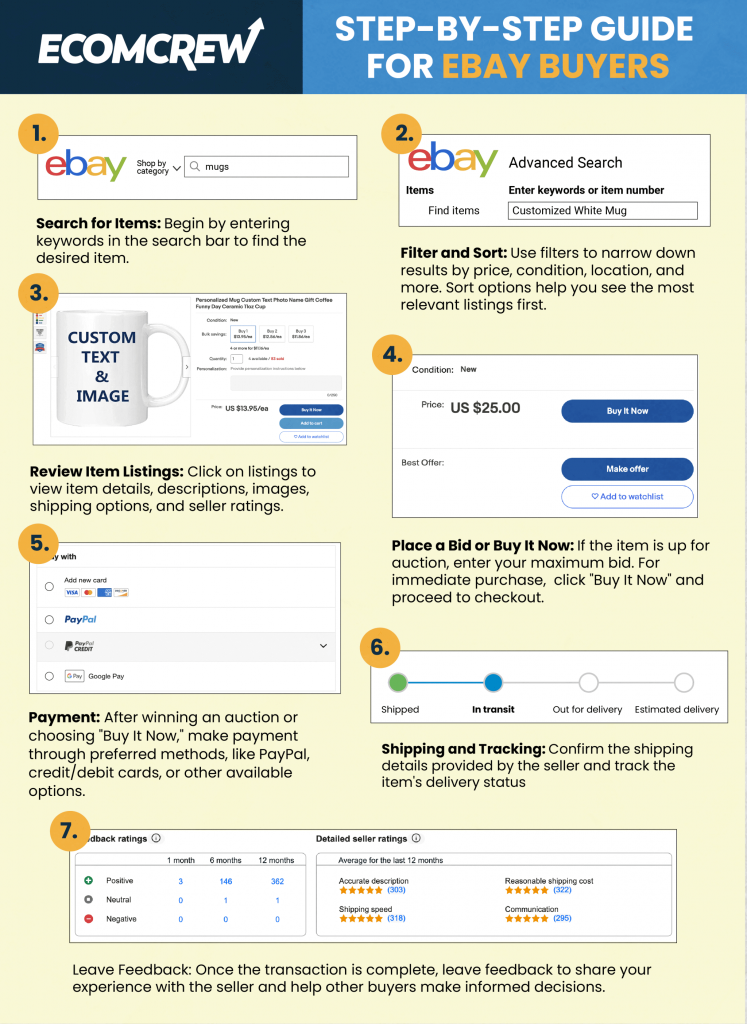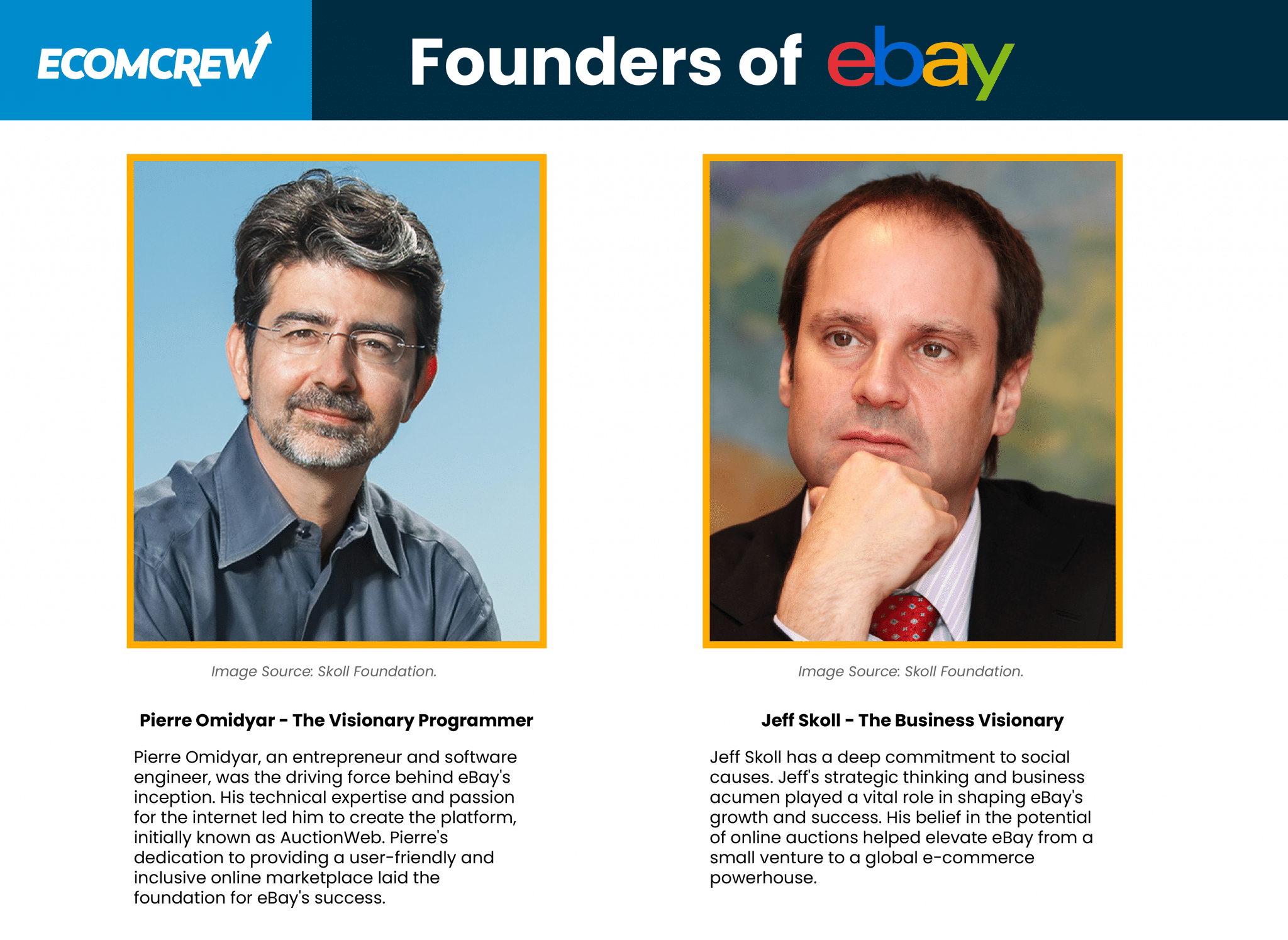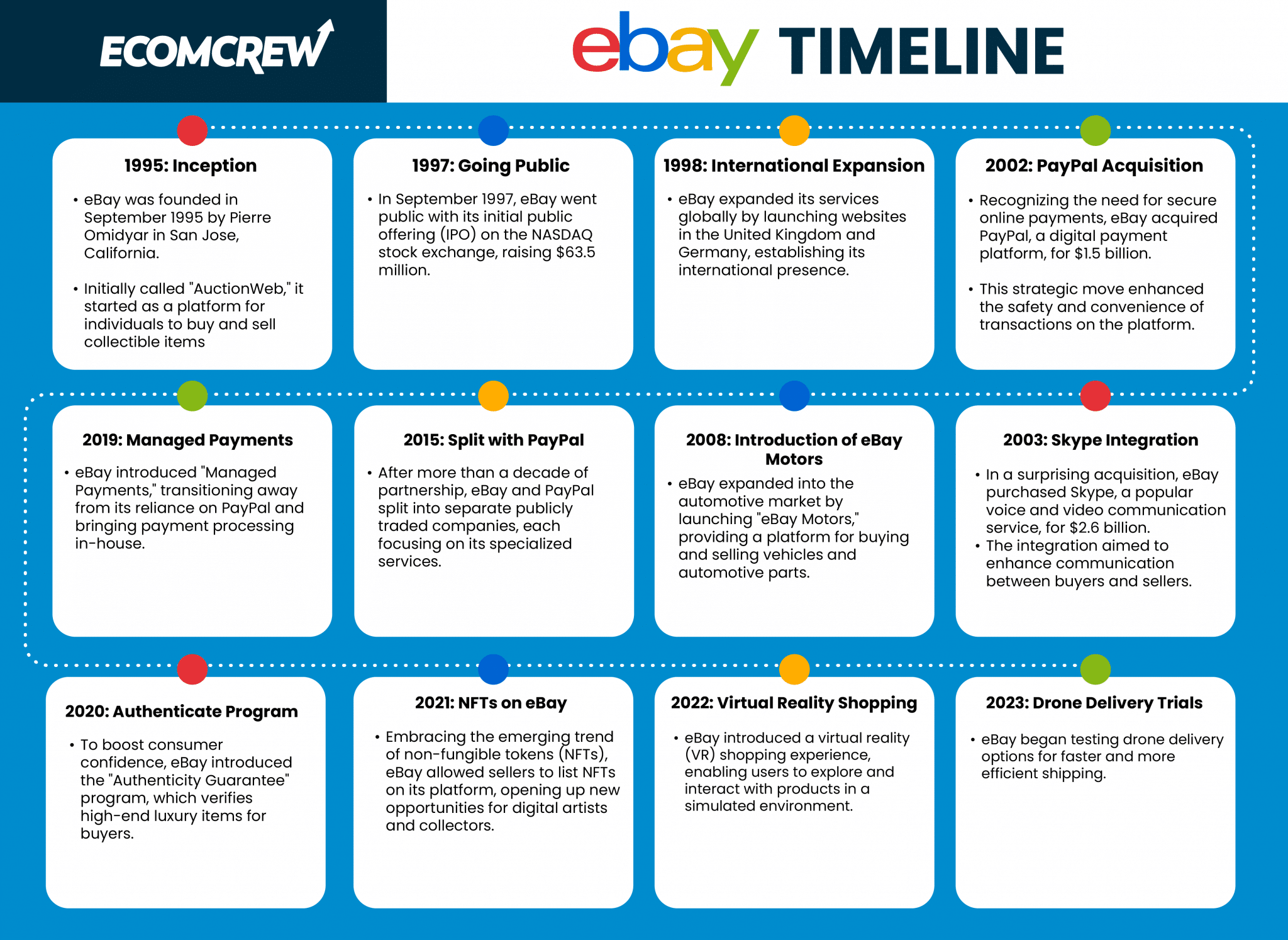The History of eBay: Facts and Timeline

eBay, the trailblazing online auction platform, has left an indelible mark on the e-commerce industry since its inception. Founded in 1995, eBay revolutionized the way people buy and sell items, transforming the concept of online shopping. Over the years, it has grown into a global powerhouse, connecting millions of buyers and sellers across the world.
This article presents a concise and informative journey through the captivating history of eBay. From its humble beginnings to its remarkable growth, we will explore the founders' vision and the key milestones that shaped its trajectory.
Related Reading: Beginner’s Guide to Selling on eBay
The Birth of eBay
eBay was the brainchild of Pierre Omidyar, an entrepreneur and software engineer, and his partner, Jeff Skoll, a visionary businessman. Pierre's background in computer programming and his passion for the internet, combined with Jeff's acumen for business and social causes, laid the groundwork for eBay's innovative approach to e-commerce.
The idea for eBay was sparked when Pierre Omidyar realized the potential of the internet as a platform for people to buy and sell unique items in an auction-style format. Inspired by a personal interest in collectible items, he sought to create a virtual marketplace where anyone could participate in a lively bidding process from the comfort of their homes.
In September 1995, eBay was officially launched as “AuctionWeb.” The initial version of the platform allowed people to list items and engage in auctions.
The response was overwhelming, and soon, eBay's servers struggled to keep up with the growing demand. Despite the challenges, the team persevered, continually refining the website to provide a seamless experience to users.
eBay's Timeline
Over the years, eBay achieved significant milestones that solidified its position as a market leader. From the exponential increase in user base to strategic acquisitions like PayPal, Skype, and StubHub, eBay diversified its offerings and expanded its reach. Technological advancements, such as introducing mobile apps and implementing secure payment systems, further fueled the company's growth and adaptability.
Each milestone played a crucial role in eBay's success. The ever-expanding user base fostered a vibrant community and attracted more sellers, leading to a diverse range of products. Acquisitions, like PayPal, facilitated secure transactions and built trust among users, while other ventures, such as Skype, improved communication within the eBay ecosystem. These strategic moves cemented eBay's position as a go-to platform for online shopping, making it a household name globally.
How eBay Works
For buyers, the journey begins with searching for the desired item, followed by placing bids or purchasing products immediately through “Buy It Now.” Sellers, on the other hand, list their items with detailed descriptions and visuals, setting a starting price or enabling bidding. The highest bidder wins the item at the end of the auction period, or it sells instantly through “Buy It Now.”
Related Reading: How Bidding on eBay Works: 4 Easy Steps
Trust is the backbone of eBay's thriving community. Feedback and ratings play a pivotal role in building and maintaining trust between buyers and sellers. After a transaction, both parties have the opportunity to leave feedback about their experience. Positive feedback helps build a seller's reputation, while buyers with good feedback are deemed trustworthy. This system encourages accountability and ensures transparency, promoting a secure and reliable shopping environment for all eBay users.

Funding and Growth
Omidyar initially developed the site as a side project while working for a consulting firm. The website's first item sold was a broken laser pointer, which surprised Omidyar and inspired him to continue the project. The platform's early growth and success can be attributed to Omidyar's dedication and the positive word-of-mouth generated by users who found value in the online auction experience.
As AuctionWeb grew, it needed additional funding to support its expansion. In 1997, Omidyar decided to seek outside investment and incorporated the company under the name eBay. During this phase, eBay secured investments from venture capital firms, most notably from Benchmark Capital, which played a crucial role in providing funding and strategic guidance. The influx of capital allowed eBay to invest in infrastructure, marketing, and technological advancements, leading to rapid growth and increased user engagement.
Strategies for attracting users and sellers to eBay:
eBay employed several key strategies to attract users and sellers to its platform. These strategies included:
- User-friendly interface. eBay's platform was designed to be accessible and easy to use, even for non-technical users. This simplicity attracted a broad demographic and encouraged more people to participate in online auctions.
- Trust-building measures. eBay introduced buyer and seller feedback systems that allowed users to rate and review their transaction experiences. This created a sense of trust and transparency within the community and incentivized good behavior.
- Diverse product offerings. By allowing users to sell a wide variety of items, from collectibles to everyday products, eBay catered to a broad audience, making it a one-stop-shop for buyers and sellers.
- Global expansion. eBay focused on expanding its presence internationally, tailoring its platform to accommodate users from various countries. This allowed eBay to tap into new markets and attract a diverse range of buyers and sellers worldwide.
- Marketing and promotion. eBay invested in marketing campaigns to raise awareness of its platform and attract new users. Their advertisements showcased the unique items available on eBay and emphasized the excitement of participating in online auctions.
- Mobile accessibility. Recognizing the growing importance of mobile devices, eBay developed user-friendly mobile apps, enabling users to buy and sell on the go. This mobile accessibility increased user engagement and convenience, catering to the changing preferences of modern consumers.
The Rise of Online Auctions
eBay played a pioneering role in popularizing online auctions and redefined how people buy and sell goods. Prior to eBay, online auctions were relatively unknown to the general public. The platform's success and innovative features, such as the auction-style format, real-time bidding, and time-limited listings, made online auctions accessible and exciting for millions of users.
eBay's rise had a significant impact on traditional auction houses and brick-and-mortar businesses. Traditional auction houses faced increasing competition from eBay's more efficient and cost-effective online model.
eBay's platform provided an avenue for niche markets and unique collectibles to thrive. Collectors and enthusiasts found a global marketplace to buy and sell rare items that were previously difficult to access. This created new opportunities for specialized sellers and contributed to the growth of various niche markets within the e-commerce ecosystem.
eBay's Influence on E-commerce
As one of the earliest and most successful online marketplaces, eBay demonstrated the viability and convenience of e-commerce to a wider audience. It helped build consumer confidence in online transactions and contributed to the overall normalization of buying and selling goods on the internet.
Many entrepreneurs and businesses observed eBay's growth and adapted its principles to build their platforms, leading to a diverse range of online marketplaces catering to various niches and industries.
Lessons that other businesses can learn from eBay's success and challenges:
- User experience matters. eBay's user-friendly interface and transparent feedback system were pivotal in attracting and retaining users. Businesses should prioritize user experience to build a loyal customer base.
- Adaptation is key. eBay continuously evolved its platform to meet changing market demands and technology. Adapting to new trends and technologies is crucial for sustained success.
- Building trust and community. eBay's emphasis on trust-building through feedback and user ratings helped establish a strong community. Businesses should focus on fostering trust and a sense of community among their users.
- Global reach and inclusivity. eBay's global platform allowed sellers and buyers from different parts of the world to connect, fostering inclusivity and diversity. Businesses can learn from this approach by embracing diversity, catering to international markets, and creating a welcoming environment for customers from all backgrounds.
Conclusion
eBay's humble beginnings as an online auction platform led to its global prominence as a major e-commerce player. Its pioneering role in popularizing online auctions and contributions to online shopping have left a lasting impact on the industry.
However, as competition grows and technology advances, eBay must continue to adapt to maintain its relevance in the digital age. By staying innovative and addressing changing consumer needs, eBay can secure its position and continue shaping the e-commerce landscape in the future.








